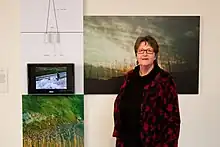Brigitte Hitschler
Brigitte Hitschler (born 1954 in Bochum, West Germany) is a German artist. Her work combines her interests in art, science and material culture, and is often environmentally focused.
Brigitte Hitschler | |
|---|---|
 Hitschler in 2011 | |
| Born | 1954 |
| Education | Technical University of Dortmund Ruhr University Bochum |
| Notable work | Energy field |
| Movement | Environmental art |
Education
Hitschler studied art, education, and German at the Technical University of Dortmund and at Ruhr University Bochum.[1] Hitschler works for the [ID]factory at the Technical University of Dortmund.[2]
Works
Hitschler is interested in science and material culture as well as art. Her environmental installation Energy field (1999) reflects all three concerns. It was created on top of a potash slag heap in Hannover-Empelde, Germany. The area was closed in 1972 and slated for reclamation. In 1999, it was opened to artists for an exhibition project. For her installation, Hitschler created 400 light-emitting diodes, which used ongoing chemical processes within the potash heap as a power source. Each diode rested atop two 40 cm long and 2 mm thin brass tubes. The tubes were connected with magnesium, copper and zinc. Galvanic cells absorbed power from the hill to turn on the light. The tiny red diodes were placed in a sixteen-square meter area.[3] Video and photographs documenting the installation have been shown nationally and internationally in exhibits such as Elemental Matters, 2011, at the Chemical Heritage Foundation.[4][5][6][7]
Glimmering lights invoke the slumbering, hidden forces of the hill... They symbolize the past and future energy potential of the place. – Brigitte Hitschler[3]
Hitschler's works include:
- Lüntec, painting, Technology Center Lünen, Germany, 2001[8][9]
- Energy field, installation, Hannover-Empelde, Germany, 1999; Video-installation, Harenberg City-Center, Dortmund/Germany, 1998
- Dayflies, text collage, Theatre of Hannover, Hannover, Germany, 1998
- Objects, painting & video, Torhaus Rombergpark, Dortmund, Germany, 1998
- Grottenolm, video, Marsberger Musiktage, Marsberg, Germany, 1998
- The way it begins, video installation, art society, Villa Streccius, Landau, Germany, 1998
- not quite the right blue ..., video installation, University of Iowa City, Iowa, USA, 1998
- Wir zweifeln jetzt anders, work in public space, text installation (stainless steel), University of Dortmund, Germany, 1997/98[10]
References
- Peeler, Allison. "Bridgette Hitschler". See transcript.
- "[ID]factory für den N.I.C.E. Award nominiert!". Technische Universität Dortmund. 2014. Retrieved 27 February 2016.
- "Chemistry in Art A Virtual Art Exhibition Jointly Published with the Special Issue on "Aesthetics and Visualization in Chemistry"" (PDF). Hyle: International Journal for Philosophy of Chemistry. 9 (3). 2003. Retrieved 27 February 2016.
- Brouwer, Chris; Schaefer, Madeline (2011). "New Exhibit Kicks Off the U.S. Celebration of IYC 2011". Chemistry International. 33 (3). Retrieved 27 February 2016.
- Donohoe, Victoria (18 February 2011). "Show features all 118 elements:Elemental matters: Artists celebrate chemistry's gifts". Philadelphia Inquirer. Archived from the original on 12 July 2016. Retrieved 27 February 2016.
- Schneider, Christy (2010). "Elemental Matters". Chemical Heritage Magazine. 28 (3). Retrieved 26 March 2018.
- "Brigitte Hitschler: mesmo campo, à noite". Arte e Ciências. Retrieved 27 February 2016.
- "Brigitte Hitschler". säen pflegen ernten. Retrieved 27 February 2016.
- "Brigitte Hitschler, nossa próxima artista". Arte e Ciências. Retrieved 27 February 2016.
- Lünnemann, Ole (29 June 1998). "Rosa Kunst und rohe Technik rücken zusammen". Informationsdienst Wissenschaft. Universität Dortmund. Retrieved 27 February 2016.